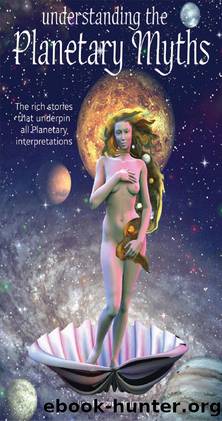Understanding the Planetary Myths by Lisa Tenzin-Dolma

Author:Lisa Tenzin-Dolma
Language: eng
Format: epub
Tags: planets, mythology
Publisher: W. Foulsham & Co. Ltd
Neptune â Poseidon
Poseidon guards his secrets closely, hides them in the numinous realm of the subconscious. Dreams and nightmares, visions and illusions are his domain. The mind that seeks to go beyond these, to discover the truth behind the seductive trappings of maya, must first dive into Poseidonâs realm and risk all to bring the pearl of wisdom to the surface.
Too shallow a dive and only confusion awaits: too deep, and madness beckons. Poseidon makes his own rules, and breaks them when he wishes to.
Yet make a friend of this elusive god and gateways into mystery are opened. The ecstasy of spiritual communion, the wordless song of the self is reached when Poseidon chooses to turn the key and allow access to the deep self.
The Birth of Poseidon
Poseidon was one of the sons of Cronus and Rhea. In the best-known version of the myths, he was swallowed by Cronus at birth and was later rescued when Zeus challenged his father and forced him, with potent herbs provided by Metis, to regurgitate his siblings. The three brothers drew lots for the realms and Poseidon won the sea and from then onwards ruled the waves.
His emblems became the white horse, the bull and the trident. White horses with golden manes drew his chariot over the sea and he used his trident to stir up the waves to a frenzy, creating storms, when he was angry. The bull reflects his stubborn nature.
There is another version of the birth of Poseidon, however. In this, Rhea substituted a foal for the newborn child but Cronus, realising this, took Poseidon and threw him into the sea, expecting him to drown. Instead, he survived and the waters became his domain.
Personality Traits
Poseidon was a tempestuous god. Like the sea, he could be peaceful, but often he was violent and vengeful, with a tendency to quarrel with others and to seek retribution if he did not get his own way. He brought forth raging storms that destroyed all in their path, would deprive areas of water if he was offended (and he was easily offended), and was a fearful opponent.
When in a calmer frame of mind, he would lull the waves and dissipate storms by riding his chariot over the sea, pulled by white horses. Even now, the frothy crests of waves are called âwhite horsesâ in remembrance of him.
He grew fierce if he found that he had been deceived. When King Minos of Crete asked Poseidon for help, the god sent a white bull from the waves, stipulating that it was to be sacrificed to him. But the bull was so beautiful that Minos sacrificed another in its stead and hid the bull away.
The god, in revenge, caused Minosâ wife, Pasiphae, to fall in love with the beast and mate with it. From this union came the Minotaur, a fierce creature that was half-man, half-bull and demanded human flesh. King Minos built a labyrinth as a home for the bull and each year sent young men and women as sacrifices to the creature.
Download
This site does not store any files on its server. We only index and link to content provided by other sites. Please contact the content providers to delete copyright contents if any and email us, we'll remove relevant links or contents immediately.
| Fairy Tales | Folklore |
| Mythology |
Circe by Madeline Miller(8005)
Confessions of an Ugly Stepsister by Gregory Maguire(7830)
A Court of Wings and Ruin by Sarah J. Maas(7648)
Burn for You (Slow Burn Book 1) by J.T. Geissinger(7028)
The Bird and the Sword by Amy Harmon(5193)
A Lesson in Thorns (Thornchapel Book 1) by Sierra Simone(5033)
Into the Drowning Deep by Mira Grant(4413)
Stolen (Alpha's Control Book 1) by Addison Cain(4141)
The Queen and the Cure (The Bird and the Sword Chronicles Book 2) by Amy Harmon(3975)
Mythology by Edith Hamilton(3714)
Pernicious Red (When The Wicked Play Book 1) by Natalie Bennett(3478)
Run Little Wolf (The Forest Pack Series Book 1) by G. Bailey(3457)
The Queen and the Cure by Amy Harmon(3190)
(Maiden Lane #5) Lord of Darkness by Elizabeth Hoyt(3016)
Lost Boy by Christina Henry(2974)
Mythos by Stephen Fry(2806)
The Fairy Queen (The Dark Queens Book 6) by Jovee Winters(2768)
Persephone by Kitty Thomas(2651)
Bunny by Mona Awad(2354)
